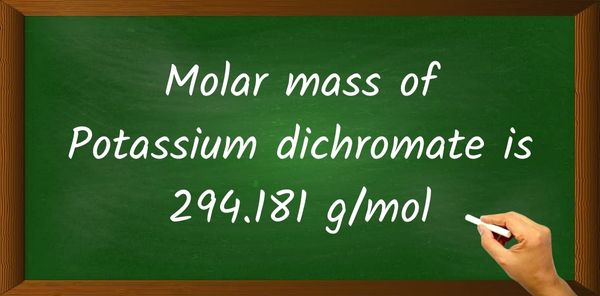
Molar mass of K2Cr2O7 (Potassium dichromate) is 294.181 g/mol.
Well, now you have come to know the molar mass of K2Cr2O7.
But how can you get this value?
Let me show you the calculation to get the molar mass of K2Cr2O7 (Potassium dichromate).
If you are a visual learner like me, then here is a short one minute video for you.
K2Cr2O7 (Potassium dichromate) Molar Mass Calculation
If you have a periodic table with you, then you can easily calculate the molar mass of K2Cr2O7 (Potassium dichromate).
Because the molar mass of any molecule (or compound) can be calculated by simply adding the molar masses of individual atoms.
Now here we have to find the molar mass of K2Cr2O7 (Potassium dichromate).
So for that, have a look at the periodic table given below.

You can see the molar mass value of all the atoms from this periodic table.
Now in K2Cr2O7, there are 2 Potassium atoms, 2 Chromium atoms and 7 Oxygen atoms.
So let’s look at the molar mass of Potassium, Chromium and Oxygen from the above periodic table.
You can see that;
The molar mass of Potassium is 39.098 g/mol. [1]

The molar mass of Chromium is 51.996 g/mol. [2]

The molar mass of Oxygen is 15.999 g/mol. [3]

Now, to calculate the molar mass of K2Cr2O7, you just have to add the molar mass of all the individual atoms that are present in K2Cr2O7.
You can see that in K2Cr2O7, there are 2 Potassium atoms, 2 Chromium atoms and 7 Oxygen atoms.
So, Molar mass of K2Cr2O7 = Molar mass of 2 Potassium (K) atoms + Molar mass of 2 Chromium (Cr) atom + Molar mass of 7 Oxygen (O) atoms.
= (39.098) 2 + (51.996) 2 + (15.999) 7
= 78.196 + 103.992 + 111.993
= 294.181 g/mol
Hence the Molar mass of K2Cr2O7 is 294.181 g/mol.
I hope you have understood the short and simple calculation for finding the molar mass of K2Cr2O7.
Remember
- In some books, you may see the unit of molar mass as grams/mole or g/mole. But all these units (i.e g/mol, grams/mole and g/mole) are the same.
- Always follow the calculation order to avoid any mistakes in calculation. First solve the brackets, then multiplications and at last do the final addition.
- And don’t forget to put the unit g/mol to your final calculated molar mass.
Check out other related topics for more practice;
Chloroform (CHCl3) Molar Mass
Pentane (C5H12) Molar Mass
LiOH (Lithium hydroxide) Molar Mass
NaI (Sodium iodide) Molar Mass
Aluminum nitrate [Al(NO3)3] Molar Mass
Jay is an educator and has helped more than 100,000 students in their studies by providing simple and easy explanations on different science-related topics. With a desire to make learning accessible for everyone, he founded Knords Learning, an online learning platform that provides students with easily understandable explanations.
Read more about our Editorial process.
